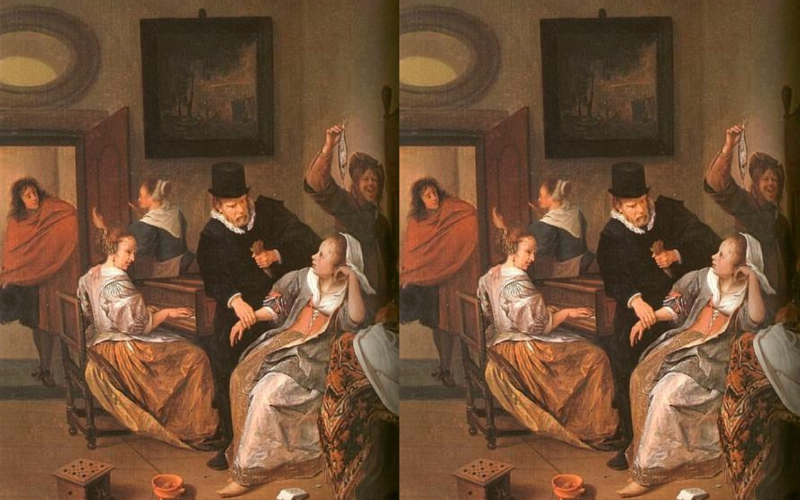The most common medical representation in Dutch genre paintings from the 17th century was the doctor’s visit.
Jan Steen depicted the common theme in eighteen paintings, usually featuring a young woman who is afflicted with a condition related to love. The condition of lovesickness, also known as minne-pijn or minne koortz in Dutch, which means “pain or fever of the heart,” was covered in medical essays in the 17th century.
Marriage was the only socially acceptable treatment for the strange condition. Steen displayed variation and developed each face differently in works like Doctor’s Visit (ca. 1661–1662), The Lovesick Maiden (ca. 1660), Doctor’s Visit (ca. 1660), and Doctor’s Visit (ca. 1663).
The Painting
Doctor’s Visit is among the most intriguing illustrations of Steen’s handling of the subject (1663-1665). Steen uses wit and humor to convey a moving commentary on the subject in the painting. The doctor is seen checking the young woman’s pulse as the housekeeper opens the door and lets a young man—possibly the girl’s lover—in. Except for the doctor, everyone else in the room appears to be aware of the patient’s condition.
The artist highlights the doctor’s apparent state of amnesia; he appears perplexed by the maiden’s accelerated heartbeat and is completely unaware that she has spotted her lover in the doorway behind him. Steen even dressed the doctors in a vintage outfit that resembles a theater costume in some ways.
A love letter and a container with a smoldering ribbon, which was a quacks’ method for determining pregnancy, are on the ground next to the maiden’s foot. In one version of the test, the ribbon was burned after being dipped in the patient’s urine, and if the patient felt queasy from the smell, it indicated that she was pregnant.
The harpsichord is being played by the woman who occupies the composition’s center. Music was once thought to be both a symbol of love and a cure for melancholy; in this case, it might stand in for the harmony between the two lovers. All of these particulars have been strategically positioned to suggest the situation and spark the viewer’s imagination.
Most significantly, Steen enters the frame in the composition’s upper right corner. He displays two onions and a herring, which are suggestive and may be a phallic symbol. This symbolism gives the painting a sense of foolishness and absurdity. Steen mimics the fool of the Dutch rhetoricians by donning a slashed beret, but he also reinvents this well-known type.
Despite being a part of the composition, Steen directly addresses the audience to highlight his function as a commentator. He serves as a visual cue to the viewer that the scene is staged by positioning himself outside.
Steen explores the metaphor of the world as a stage, a notion that was very popular in 17th-century Dutch culture, by incorporating a theatrical influence of Dutch rhetoricians into the painting.


